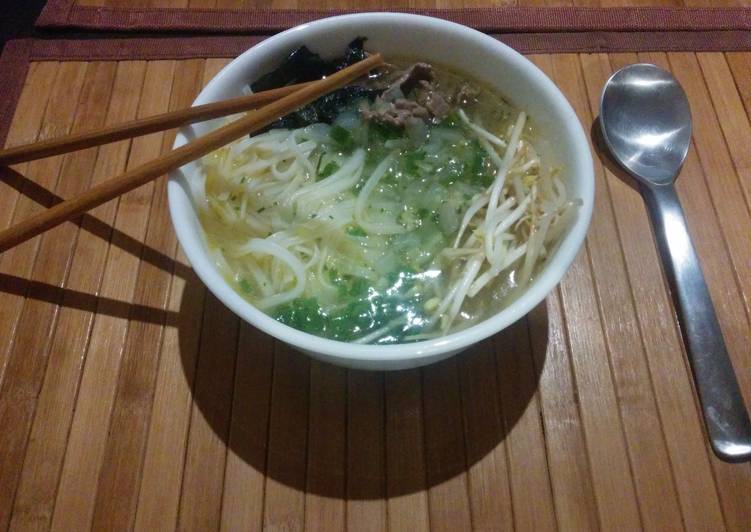Traditional Japanese Ramen (with beef). If traditional Japanese ramen is what you're after, you'll need to head over to my mother's website RecipeTin Japan. She's shared Japanese Ramen Noodles with the broth made from scratch, and quick and easy traditional ramen using sort-of instant ramen. Löydä HD-arkistokuvia ja miljoonia muita rojaltivapaita arkistovalokuvia, -kuvituskuvia ja -vektoreita Shutterstockin kokoelmasta hakusanalla Traditional Japanese Soup Ramen Beef Egg.
 Learn about Japanese ramen, including the different components of a ramen dish, how to make ramen noodles, popular regional dishes, and more.
If you have spent any time living in Japan or socialising with Japanese people, chances are that you are aware of how much Japan loves ramen.
Nowadays, ramen is high in the running for national dish of Japan.
you can cook Traditional Japanese Ramen (with beef) using 16 ingredients and 7 steps. Here is how you achieve that.
Learn about Japanese ramen, including the different components of a ramen dish, how to make ramen noodles, popular regional dishes, and more.
If you have spent any time living in Japan or socialising with Japanese people, chances are that you are aware of how much Japan loves ramen.
Nowadays, ramen is high in the running for national dish of Japan.
you can cook Traditional Japanese Ramen (with beef) using 16 ingredients and 7 steps. Here is how you achieve that.
Ingredients of Traditional Japanese Ramen (with beef)
- Prepare of broth.
- You need 1 1/2 liter of chicken broth.
- Prepare 1 tbsp of ginger, finely chopped.
- Prepare 1 tbsp of red pepper, finely chopped (optional, if you like spicy).
- It's 2 tbsp of chives, finely chopped.
- Prepare 2 tbsp of soy sauce.
- You need 4 tbsp of sesame oil.
- It's 2 of garlic cloves, finely chopped.
- You need 4 grams of Hondashi soup stock.
- It's 2 tbsp of scallion tails (finely chopped).
- You need of dish.
- Prepare 300 grams of Rice ramen.
- It's 4 tbsp of scallions (just the tails), finely chopped.
- You need 1 of Nori (sushi seaweed) cut in small strips (1x3cm).
- It's 2 of thin beef steaks, cut in small pieces.
- It's 200 grams of bean sprouts.
Museums have opened dedicated to its history. While it's true that even with strictly Japanese style ramen, some folks see those four classes as distinct, there are plenty of cases where there are overlaps and outliers. Although Japan does have a hefty selection of pre-packaged, dried ramen ready for boiling water and a seasoning The most common way to serve ramen is with a slice of pork. It's a dish that demands an element of 'free styling' to really master and isn't something you just I recently started making ramen with my pasta roller and was pleasantly surprised how easy it is to make standard ramen noodles with the baked.
Traditional Japanese Ramen (with beef) step by step
- Prepare all ingredients (chop, cut, etc.).
- Start boiling the chicken broth..
- Meanwhile, heat a pan with the sesame oil, and start cooking the garlic for 1 minute (until golden.) Then add to the pan the soy sauce, 2tbsp of the scallion tails, the chopped chives, the ginger and the red pepper. Cook for ~2 minutes. This will your ramen broth seasoning..
- Pour into the boiling chicken broth the ramen seasoning that you cooked in step 3. Also add the Hondashi soup stock. Keep boiling and stirring the broth for 10 more minutes..
- Meanwhile put the rice ramen in plain boiling water. It will take about 3 or 4 minutes to cook. It should be "al dente." Once cooked, rinse it with cold water to stop the cooking process..
- Prepare the plate: In a deep soup plate put some rice ramen, some 1 tbsp of the remaining scallions, some bean sprouts, 1/4 of the beef and some Nori leave pieces. TIP: try to accommodate these ingredients in the same way for all plates: just looks nice... :).
- Just before serving, pour the prepared broth to fill the plate to serve. Enjoy!.
Bowl with japanese ramen with pork belly and mushrooms with marinated eggs on green linen tablecloth. Learn about the noodles, flavored soup, and many toppings of the iconic Japanese dish and some of the most common kinds. Ramen are very popular noodle dishes in Japan, and boiled noodles are basically served in different flavored soup with many toppings. Japanese Ramen Noodles with a Twist. Besides traditional ramen varieties, there are also other Japanese dishes which, although similar to Japanese ramen noodles, should be clearly separated from the standard understanding of traditional ramen.